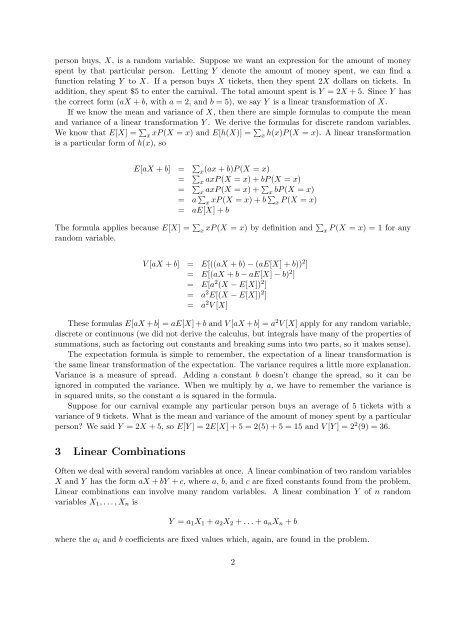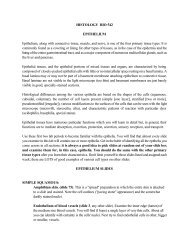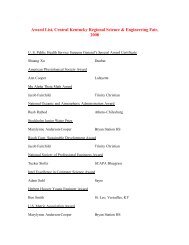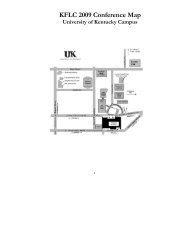Linear Transformations and Combinations
Linear Transformations and Combinations
Linear Transformations and Combinations
Create successful ePaper yourself
Turn your PDF publications into a flip-book with our unique Google optimized e-Paper software.
person buys, X, is a r<strong>and</strong>om variable. Suppose we want an expression for the amount of money<br />
spent by that particular person. Letting Y denote the amount of money spent, we can find a<br />
function relating Y to X. If a person buys X tickets, then they spent 2X dollars on tickets. In<br />
addition, they spent $5 to enter the carnival. The total amount spent is Y = 2X + 5. Since Y has<br />
the correct form (aX + b, with a = 2, <strong>and</strong> b = 5), we say Y is a linear transformation of X.<br />
If we know the mean <strong>and</strong> variance of X, then there are simple formulas to compute the mean<br />
<strong>and</strong> variance of a linear transformation Y . We derive the formulas for discrete r<strong>and</strong>om variables.<br />
We know that E[X] = <br />
<br />
x xP (X = x) <strong>and</strong> E[h(X)] = x h(x)P (X = x). A linear transformation<br />
is a particular form of h(x), so<br />
The formula applies because E[X] = <br />
x<br />
r<strong>and</strong>om variable.<br />
E[aX + b] = <br />
x (ax + b)P (X = x)<br />
= <br />
x axP (X = x) + bP (X = x)<br />
= <br />
<br />
x axP (X = x) + x bP (X = x)<br />
= a <br />
<br />
x xP (X = x) + b x P (X = x)<br />
= aE[X] + b<br />
<br />
xP (X = x) by definition <strong>and</strong> x P (X = x) = 1 for any<br />
V [aX + b] = E[((aX + b) − (aE[X] + b)) 2 ]<br />
= E[(aX + b − aE[X] − b) 2 ]<br />
= E[a 2 (X − E[X]) 2 ]<br />
= a 2 E[(X − E[X]) 2 ]<br />
= a 2 V [X]<br />
These formulas E[aX + b] = aE[X] + b <strong>and</strong> V [aX + b] = a 2 V [X] apply for any r<strong>and</strong>om variable,<br />
discrete or continuous (we did not derive the calculus, but integrals have many of the properties of<br />
summations, such as factoring out constants <strong>and</strong> breaking sums into two parts, so it makes sense).<br />
The expectation formula is simple to remember, the expectation of a linear transformation is<br />
the same linear transformation of the expectation. The variance requires a little more explanation.<br />
Variance is a measure of spread. Adding a constant b doesn’t change the spread, so it can be<br />
ignored in computed the variance. When we multiply by a, we have to remember the variance is<br />
in squared units, so the constant a is squared in the formula.<br />
Suppose for our carnival example any particular person buys an average of 5 tickets with a<br />
variance of 9 tickets. What is the mean <strong>and</strong> variance of the amount of money spent by a particular<br />
person? We said Y = 2X + 5, so E[Y ] = 2E[X] + 5 = 2(5) + 5 = 15 <strong>and</strong> V [Y ] = 2 2 (9) = 36.<br />
3 <strong>Linear</strong> <strong>Combinations</strong><br />
Often we deal with several r<strong>and</strong>om variables at once. A linear combination of two r<strong>and</strong>om variables<br />
X <strong>and</strong> Y has the form aX + bY + c, where a, b, <strong>and</strong> c are fixed constants found from the problem.<br />
<strong>Linear</strong> combinations can involve many r<strong>and</strong>om variables. A linear combination Y of n r<strong>and</strong>om<br />
variables X1, . . . , Xn is<br />
Y = a1X1 + a2X2 + . . . + anXn + b<br />
where the ai <strong>and</strong> b coefficients are fixed values which, again, are found in the problem.<br />
2









